QuestionI recently got a 3 year old cocker spaniel female. aside from being timid and not housebroken, my new dog is awesome and very loving. how do i house break a dog who was used to being outside? She loves to be indoors now and even sleep in my bed with me. She is however not a people dog. she loves my daughter, tolerates my mother, is getting used to my older brother when stops by, but other than that she doesnt like to be around people much. Whenever I have visitors stop by my home she usually runs into my bedroom and lays on the bed until they are gone. i have gone and gotten her out of the room a few times just to assure her that it is ok and noone will hurt her. Unless I shut off all the room doors except the room i am in, she will have nothing to do with visitors. She used to growl at my brother but now she is slowly getting used to him. She hardly ever barks for anything. She barked once because she saw her own relfection in the mirror How i get her to be more social? I truely love my dog and I wouldnt trade her for the world but her toileting habits are costing the price of new carpet. How do I train a dog at her age? I take her outdoor as soon as she eats and drinks (supervised and unsupervised)but she still insist on using the carpet instead. I can put her outside for hours and she wont go on the ground like she is supposed to. If I stay outside with her she thinks it is playtime or she will just lay down at my feet and wait to go back inside. I dont know what to do at this point......Please Help Me
AnswerAt 3 years old, a dog's personality is mature, and difficult to change. It does sound like she is doing better with people. Do not force people on her. Let them offer her treats. If she is not getting many treats, a piece of her kibble is good enough.
The housebreaking sounds like a big problem. She is not behaving as I would expect. Little puppies need to eliminate very soon after eating or drinking, but 3 year olds will need more time. Observe her, and try to anticipate when she need to go. Then take her out and walk her. Keep her going with only occasional chances to sniff around a little. Alternatively it could be active play. Either way, keep her going unless she starts sniffing the ground. Eventually the exercise will be too much for her body, and she will have to go. Go bananas raving about what a good dog she is when she is finished. If you are using treats much, give her one.
Make sure she is up to date on her shots, and at least 2 weeks since her last DLCP. Take her places frequented by male dogs, the traditional fire hydrant, trees, mailboxes, etc. Let her sniff as much as she wants. The males are leaving messages for her. Even a spaded female will want to reply. Again, the praise, push the limits of what you are willing to do out in public.
The Spotbuster puppy raisers value, may help with her too. There are some other puppy techniques that may help. It is easier for me to paste in the whole thing and let you find the parts you need.
Housebreaking starts before you get home with the new puppy. If you don't have
a crate, buy one. I prefer the more enclosed, den like plastic ones. Skip the
bedding. At first it gets wet, and later it can be chewed into choking
hazards. A wire rack in the bottom will help keep the puppy up out of
accidents at first. They are available with the crates, but a piece of closely
spaced wire closet shelving from a home supply place is cheaper. If you
already have a metal crate, covering it may help. Just make sure you use
something the puppy can't pull in and chew. Dogs that start out in crates as
little puppies, accept them very well. Never leave an unattended puppy loose
in the house. If nobody can watch it, put it in the crate. I suggest letting
the dog have its crate all its life.
Choose a command and spot you want it to use. The less accessible to strays,
the less chance of serious disease. If it is a female, choosing a
non grassy spot will avoid brown spots later. When you bring it home, take it
to the spot and give it the command in a firm, but friendly voice. Keep
repeating the command and let the puppy sniff around. If it does anything,
praise it. Really let it know what a good dog it is and how much you love it,
and maybe a treat. Note, being out there not only means you can praise it,
but it also keeps it from being snatched by a hawk. If it doesn't go, take it
inside and give it a drink and any meals scheduled. A young puppy will need to
go out immediately afterward. Go to the spot and follow the above routine.
Praising it if it goes is extremely important. If it doesn't go, take it back
inside and put it in its crate and try again soon. Do not let it loose in the
house until it does go.
At first it is your responsibility to know and take the puppy out when it
needs to go. It needs to go out the first thing in the morning, after eating,
drinking, and sleeping. If it quits playing, and starts running around
sniffing, it is looking for a place to go. Take it out quickly. You will just
have to be what I call puppy broke until it is a little older.
By the time most dogs are about 3 months old, they have figured out that if
they go to the door and stand, you will let them out. The praise slowly shifts
to going to the door. Some people hang a bell there for the dog to paw. If
your dog doesn't figure this out, try praising it and putting it out if it
even gets near the door. A stern "Bad dog!" is all the punishment that is
effective, and only when you catch it in the act and are sure you didn't miss
it going to the door. Clean up accidents promptly. I mostly keep the little
puppies out of the carpeted rooms. Still I need the can of carpet foam
sometimes. First blot up all the urine you can with a dry towel. Keep moving
it and stepping on it until a fresh area stays dry. A couple big putty knives
work well on bowel movements. Just slide one under it while holding it with
the other. This gets it up with a minimum of pushing it down into the carpet.
This works with even relatively soft ones, vomit, dirt from over turned house
plants, orHousebreaking starts before you get home with the new puppy. If you don't have
a crate, buy one. I prefer the more enclosed, den like plastic ones. Skip the
bedding. At first it gets wet, and later it can be chewed into choking
hazards. A wire rack in the bottom will help keep the puppy up out of
accidents at first. They are available with the crates, but a piece of closely
spaced wire closet shelving from a home supply place is cheaper. If you
already have a metal crate, covering it may help. Just make sure you use
something the puppy can't pull in and chew. Dogs that start out in crates as
little puppies, accept them very well. Never leave an unattended puppy loose
in the house. If nobody can watch it, put it in the crate. I suggest letting
the dog have its crate all its life.
Choose a command and spot you want it to use. The less accessible to strays,
the less chance of serious disease. If it is a female, choosing a
non grassy spot will avoid brown spots later. When you bring it home, take it
to the spot and give it the command in a firm, but friendly voice. Keep
repeating the command and let the puppy sniff around. If it does anything,
praise it. Really let it know what a good dog it is and how much you love it,
and maybe a treat. Note, being out there not only means you can praise it,
but it also keeps it from being snatched by a hawk. If it doesn't go, take it
inside and give it a drink and any meals scheduled. A young puppy will need to
go out immediately afterward. Go to the spot and follow the above routine.
Praising it if it goes is extremely important. If it doesn't go, take it back
inside and put it in its crate and try again soon. Do not let it loose in the
house until it does go.
At first it is your responsibility to know and take the puppy out when it
needs to go. It needs to go out the first thing in the morning, after eating,
drinking, and sleeping. If it quits playing, and starts running around
sniffing, it is looking for a place to go. Take it out quickly. You will just
have to be what I call puppy broke until it is a little older.
By the time most dogs are about 3 months old, they have figured out that if
they go to the door and stand, you will let them out. The praise slowly shifts
to going to the door. Some people hang a bell there for the dog to paw. If
your dog doesn't figure this out, try praising it and putting it out if it
even gets near the door. A stern "Bad dog!" is all the punishment that is
effective, and only when you catch it in the act and are sure you didn't miss
it going to the door. Clean up accidents promptly. I mostly keep the little
puppies out of the carpeted rooms. Still I need the can of carpet foam
sometimes. First blot up all the urine you can with a dry towel. Keep moving
it and stepping on it until a fresh area stays dry. A couple big putty knives
work well on bowel movements. Just slide one under it while holding it with
the other. This gets it up with a minimum of pushing it down into the carpet.
This works with even relatively soft ones, vomit, dirt from over turned house
plants, or anything else from solids to thick liquids. Finish up with a good
shot of carpet foam. Note, do not let the puppy lick up the carpet foam.
Once the dog is reliably housebroken, your carpet may need a good steam cleaning.
anything else from solids to thick liquids. Finish up with a good
shot of carpet foam. Note, do not let the puppy lick up the carpet foam.
Once the dog is reliably housebroken, your carpet may need a good steam cleaning.

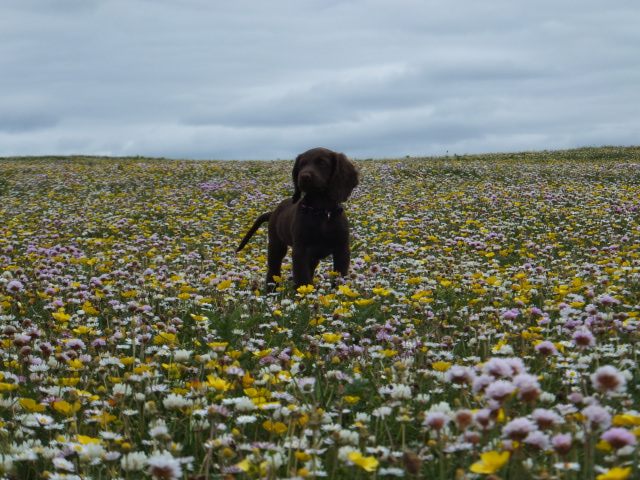 Travelling
QuestionQUESTION: Dear Dolores,
My 7 months old female
Travelling
QuestionQUESTION: Dear Dolores,
My 7 months old female
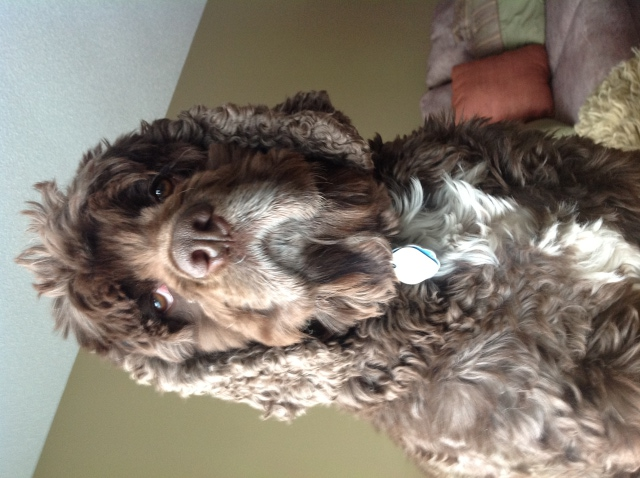 Escalating health issues
QuestionTeddy
QUESTION: First of, thank you much
Escalating health issues
QuestionTeddy
QUESTION: First of, thank you much
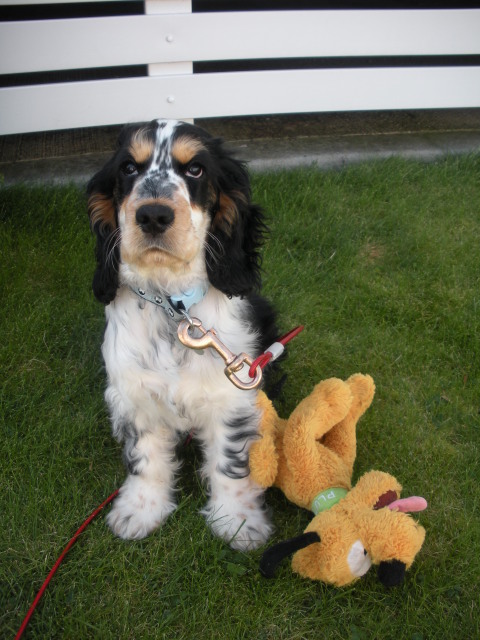 PROBLEM COCKER SPANIEL
Question
JAXON
Jaxon is a year old male neutered
PROBLEM COCKER SPANIEL
Question
JAXON
Jaxon is a year old male neutered
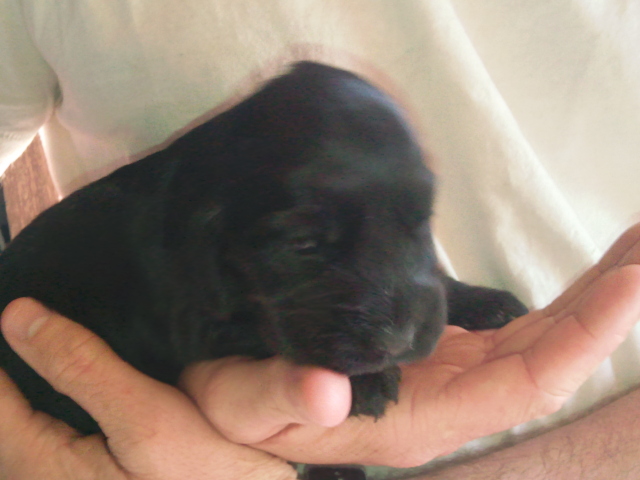 crying and food.
Questionbaby teagan
QUESTION: what is best to fe
crying and food.
Questionbaby teagan
QUESTION: what is best to fe
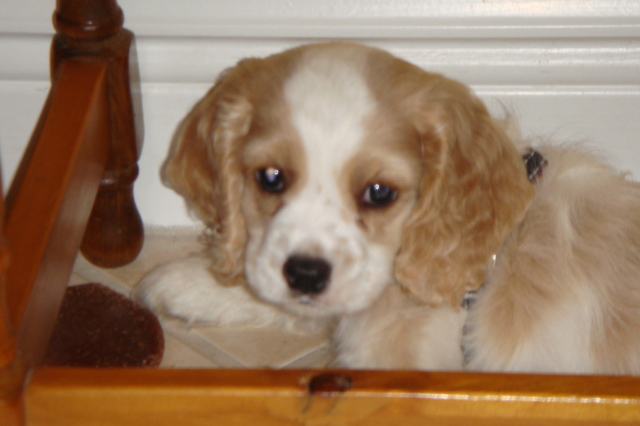 Differences between breeds
QuestionQUESTION: My puppy is 12 wks.old and weights ar
Differences between breeds
QuestionQUESTION: My puppy is 12 wks.old and weights ar